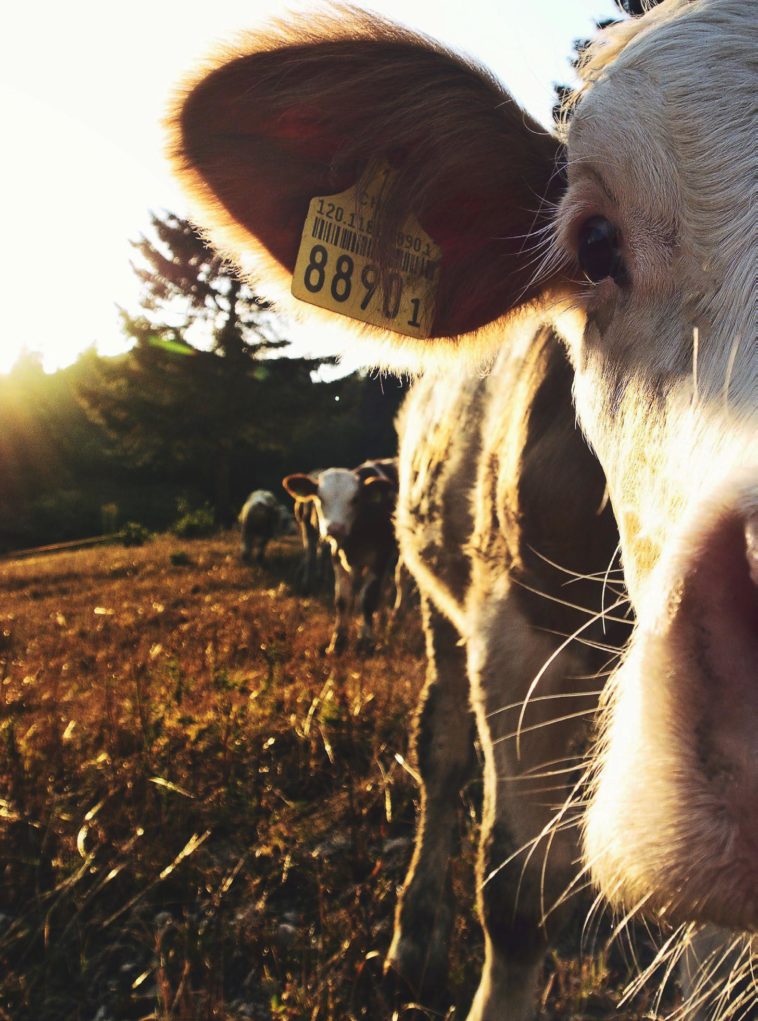The purpose of the intensive housing system for dairy cows is mainly the provision of an environment in which the stress factors which accompany milk production, as well as the adverse effects of unfavourable environmental conditions, are limited to such an extent that dairy cows can produce optimally.
An extensive housing system must comply with the following requirements:
- The micro-climate within the system must not be so warm, cold or windy that production is influenced and/or causes continuous discomfort to the cows.
- Available walking areas and lying room, as well as surfaces of floors and walls must not cause the cows discomfort or injuries. The lying room must be clean and dry.
- The design of a housing system must limit stress factors, that can decrease the cow’s production performance and general resistance to diseases.
- Air within the system must be fresh and free from any excessive amounts of carbon dioxide (as a result of breathing and some heating systems) and ammonia (resulting from manure and urine).
- Physical conditions in a housing system must be suitable for dairy cows to maintain a normal behavioural pattern at all times.
- With the design of an intensive housing system with optimal environmental conditions, biological characteristics of dairy cows, as well as general climatic conditions prevailing in a certain area should be considered.
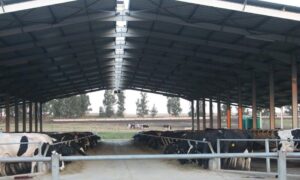
A housing system with ample air flow is desired in a warmer climate area.
Biological characteristics of dairy cows and the influence on them
Dairy cows are warm-blooded animals and have the ability to maintain a constant body temperature – within limits – (approximately 38,5 °C), despite varying environmental temperatures.
A dairy cow continuously produces body heat, of which the measure is mainly determined by the following factors:
- Basal metabolic speed
- Internal heat resulting from digestion of fodder and metabolism
- External heat as a result of air temperatures, relative humidity, air movement and radiated heat from the sun and roof or walls of the building
According to Finch (1984), metabolic heat makes up about 40% to 50% of the total heat burden of animals.
In order to keep body temperature constant, body heat must be regulated. Dairy cows however have a weak heat regulating mechanism and can, as mentioned, only regulate their body temperature slightly.
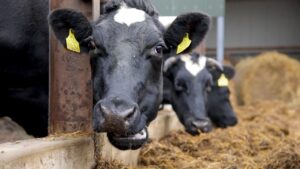
Reduced fodder intake is one of the mechanisms to regulate body temperature. (Photo courtesy of agriland.ie)
This takes place by means of the following mechanisms:
- Speeding up or slowing down breathing
- Regulating blood supply to the skin
- Radiation from or to the environment
- Radiation to the floor and/or fellow animals
- Evaporation of moisture from the skin surface – evaporation cooling
- Fodder intake
Body temperature is therefore largely the result of a dynamic balance between produced body heat, together with heat taken from the environment, against body heat radiated into the environment.
Dairy cows perform at their best between environmental temperatures of 4 to 21 °C. This is known as the comfort zone. Within the comfort zone, they can get rid of their excess body heat without detriment to production. Outside the comfort zone, the dairy cow must however make certain adaptations regarding heat production, in order to keep body temperatures constant.
The influence of different environmental conditions, like high and low temperatures, radiant heat, wind and relative humidity on the heat production of the animal is discussed in the following paragraphs:
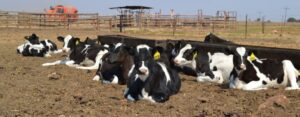
Safety in numbers is one of nature’s rules for survival. Cows use this principle to bundle together to stay warm.
High temperatures
During high temperatures the following physiological actions take place in dairy cows:
- Blood vessels in the skin are opened wider so that more blood can flow to the body surface. The skin temperature rises subsequently, so that faster radiation of body heat from the skin surface can take place to the surrounding air.
- Sweat glands in the skin begin excreting sweat. The evaporation thereof on the skin surface decreases the temperature so that more body heat can be conducted to the skin. The efficiency of heat loss that takes place in this manner largely depends on the relative humidity of the air and the speed of the wind that blows over the animal.
- The tempo of respiration increases and a large volume of cool air is inhaled. The air is heated in the lungs and saturated with water vapour before it is exhaled. A high respiration tempo in dairy cows is an efficient mechanism in getting rid of heat, however only for a short period.
- Fodder intake decreases in an attempt to decrease the production of metabolic body heat.
Low temperatures
With a decrease in the environmental temperature lower than the lowest limit of the comfort zone (approximately 4 °C), heat release will be limited to the environment in order to keep the internal body temperature constant.
Limiting of the heat loss can take place as follows:
- By making the hair stand up, a larger volume of air is trapped therein, so that the insulation capacity is increased.
- Blood vessels in the skin contract so that less blood flows to the body surface.
- Radiation of body heat from the skin surface to the environment is thus limited.
- With a higher fodder intake, the metabolic body heat is increased.
- Cows gather in groups to decrease their body surface which is exposed to the air.
With a further decrease in the environmental temperature, the animal will begin to produce additional body temperature at the lowest critical temperature, in order to prevent a decrease in body temperature. Heat production can be achieved by means of random muscle actions, such as exercise and muscle contraction (animal begins to shiver).
It must be kept in mind that the fodder level, production level and insulation capacity of the hide and hypodermic tissue will determine – to a great extent – the heat production and lowest critical temperature. With a further decrease in environmental temperature, the additional heat which is produced, cannot balance the heat radiated to the environment. The internal body temperature therefore begins to decrease and the animal can eventually die from the cold.
Some researchers are of the opinion that the determination of the lowest critical temperature of different animal species can be an indication of a specific type of animal’s resistance to cold (Young, 1981). Notwithstanding the obvious resistance of lactating cows against very low temperatures, these animals already experience clear production decreases at environmental temperatures, which are considerably higher than the predicted lowest critical temperature. The influence of rain and wind plays a clear and observable role.
Radiant heat
Radiant heat can contribute significantly to the heat burden of a dairy cow. In an open camp, the cows are exposed to the following sources of radiant heat:
- Direct sun radiation
- Reflected radiant heat from the clouds and air particles
- Radiant heat from the ground, surrounding objects and the horizon
- Radiant heat from the skin surface of animals that are kept in great numbers on small surfaces.
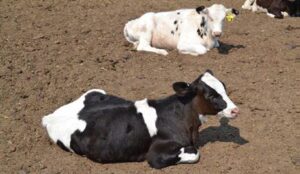
Direct sunlight contributes significantly to radiant heat.
Wind
Wind can increase the heat loss from the skin surface and the evaporation of sweat as a result of the removal of warm air that surrounds the cow. At high temperatures (above 29 °C), a wind speed of more than 15 km per hour (so-called berg wind conditions) will however increase the heat burden on the cow.
A high wind speed, together with rain and low temperatures, can impair milk production, as the insulation capacity of the hide is destroyed by rain and wind. Heat loss from the skin surface is very high as a result of poor insulation and cold stress is thus created. A great quantity of body heat is therefore needed to dry the wet coat (Baxter, 1977).
Relative humidity
Relative humidity is a measure of how much moisture is present in the air, in comparison to the amount of moisture the air can contain at a specific temperature. Heat loss as a result of respiratory evaporation and the evaporation of sweat from the skin surface is influenced to a great extent by the relative humidity levels of the air. This heatloss mechanism is hindered by high humidity levels, so that production is impaired. Relative humidity levels of between 40% and 70% are acceptable.
Published with acknowledgement to the ARC Agricultural Engineering for the use of their manuals. Visit www.arc.agric.za for more information.

